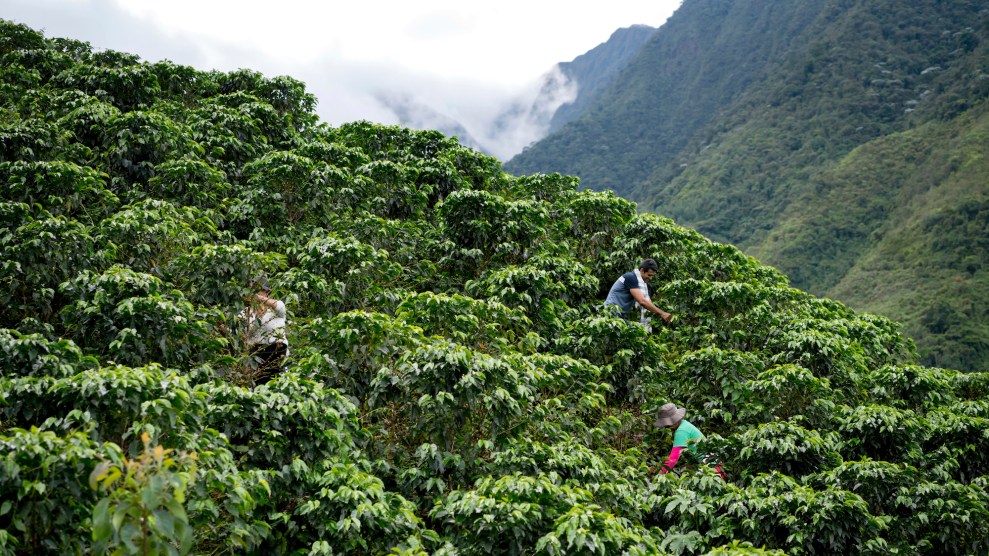
grandriver/iStock
If you’ve stepped into a hip coffee shop lately, or bought a bag of gourmet beans to grind at home, you’ve probably noticed something: Coffee now arrives with lots of information about where it came from, sometimes as specific as the name of the farm where it was grown. There’s Bella Carmona from a volcanic region in Guatemala, or Ethiopia’s Yirgacheffe varietal—which often smells of blueberries. In short, this “third-wave coffee,” as it’s known, is going the way of wine. A fine cup of joe supposedly reflects the soil and microclimates where the beans were cultivated, as well as the labor practices surrounding their harvesting.
“In the course of a few years, a fancy coffee went from a Starbucks latte to a cup of individually poured coffee from some particular cooperative in the highlands of an equatorial country,” explains journalist Alexis Madrigal. He’s the host of a new podcast called Containers, which is all about how the shipping industry shapes the global economy, and is way more riveting than you might think. He joined us on our latest episode of our food politics podcast, Bite, to talk about the “hidden back end” of the fancy coffee revolution.
This modern coffee snobbery has roots in the San Francisco Bay Area. (I know, shocking, right?). The Port of Oakland has always been a major hub for the shipping industry on the West coast. As Madrigal reports, before World War I, European importers, especially Germans, had control over the trade of high-quality Central American coffee. When war broke out and shook up European trade, Americans took advantage and financed the Guatemalan crops, bringing a steady stream of better-quality beans to the United States. In 1906, 250,000 bags of coffee came into San Francisco; by 1918, that shot up to 1 million bags. During the 20th century, vacuum packing and “cupping”—tasting of individual shipments of beans—allowed American companies to scale up and refine the industry, influencing how coffee was sipped everywhere in the country.
These bags of coffee, along with all other foods, were packed into boats in a fairly haphazard way and unloaded by longshoremen. Then shipping containers came along in the late 1960s. These standardized rectangular steel boxes “transformed everything about the way cargo moves around the world,” Madrigal explains. Containers drastically cut down the amount of labor needed, and allowed much larger quantities of goods to move much more rapidly and safely around the world.
Okay, so fast-forward to modern-day coffee snobbery. The shipping industry shaped how we drink coffee—and now, the way we drink coffee is reorganizing the shipping industry. Third-wave coffee producers, like San Francisco’s Ritual Roasters or Blue Bottle or Chicago’s Intelligentsia, have helped stoke a market for many different small batches of single-origin coffees—beans grown within a distinct geographical region—and coffee drinkers have been eager to embrace this hyperlocal trend. Each fancy single-origin coffee relies on small shipments of just a few coffee bags, or “micro-lots.” Shipping containers typically hold around 250 bags of coffee that are 150 pounds each. But a micro-lot might only be 10 or 15 bags of coffee. Which affects the supply chain—how those bags are selected and tracked and organized and accounted for. It means a “whole industry has had to reorganize itself to meet the demands of the third-wave roasters,” adding to the cost of your favorite morning tonic.
As Madrigal points out, all of this reveals “how a product, as people consume it, and the importing and distribution processes are deeply, deeply related—they drive each other.” To hear more about how shipping in the Port of Oakland is changing, and to get the scoop on Alexis Madrigal’s favorite sailor snack, listen to our full interview on Bite. And be sure to check out Containers, which introduces you to the colorful characters—from gruff captains to hearty cooks to competitive tugboat pilots—that make the shipping industry go round.
Bite is Mother Jones‘ food politics podcast. Listen to all our episodes here, or by subscribing in iTunes or Stitcher or via RSS.
















